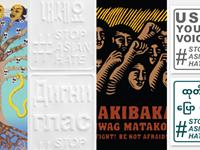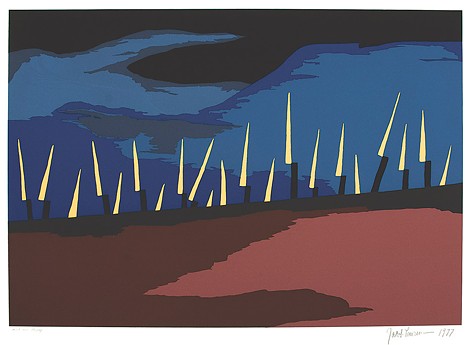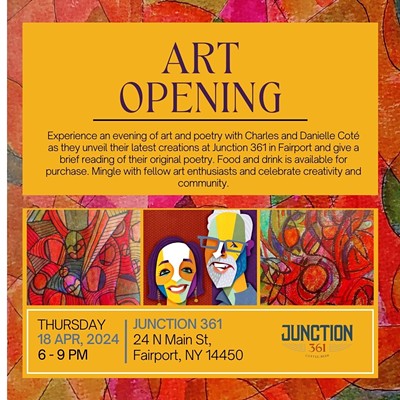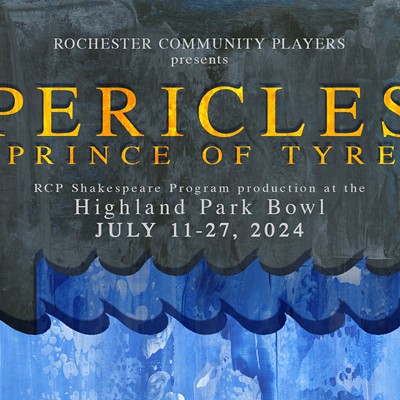Our weeping wounds
"Jacob Lawrence: The Legend of John Brown Portfolio"
By Rebecca Rafferty @rsrafferty[
{
"name": "500x250 Ad",
"insertPoint": "5",
"component": "15667920",
"parentWrapperClass": "",
"requiredCountToDisplay": "1"
}
]
Though this summer marked 150 years from the end of the Civil War, the nation remains covered in undressed wounds. And despite the desperately bloody history of slavery and the still unresolved fallout, America tends to gloss over the more violent uprisings in favor of highlighting leaders of civil disobedience. But contemporary African American artist Jacob Lawrence created a moving portfolio of prints about the life of militant abolitionist John Brown, and it's currently on exhibit at the Memorial Art Gallery.
MAG is home to 28 prints and paintings by Lawrence (who lived from 1917 to 2000), including this suite of 22 serigraph prints. In his iconic flat and colorful style, Lawrence chronicled the move of African Americans from the South to the North and the energy of life in Harlem. In this set of prints, he sympathetically depicts how Brown's steadfast mission to overthrow slavery in America helped spark the start of the war.
Many comparisons have been made between Brown and the Christ figure; like Jesus, Brown knew he would be martyred for his cause. And like Jesus's foes, Brown's opposition wanted to keep on exploiting other humans.
But Brown was a complicated figure of compassion who used deadly force against the oppression. This paradox is explored in the history-lesson wall text and in a Robert Hayden poem that accompanies the exhibit. A provided statement tells that Hayden's verse offered a look at the "unresolved conflicts" between Brown's goal of ending human bondage and his ruthlessly violent means of accomplishing this.
MAG staff have reconfigured the Lockhart Gallery, where they present smart shows drawn from the museum's collection of works on paper. They have removed the central walls, leaving a large, open space, allowing visitors plenty of room to navigate the storyline counter-clockwise around the room, beginning with Brown as a devout, middle-aged man tortured by the plight of slaves.
The stark, powerful set of images were made in 1977, based on Lawrence's original gouache paintings created in 1941. Each small picture, composed of minimal shapes of bold colors and sparse symbolism, provide to-the-point storytelling. Lawrence did not sacrifice detail in his minimal approach: Brown's craggy, world-weary face and humble but determined gestures are expertly conveyed throughout.
Through imagery and sentence-long titles, Lawrence describes that for more than a decade, Brown tried to raise funds through a variety of trades, such as land speculation and wool merchandising. But his efforts ultimately failed, and he accepted poverty without accepting defeat.
Brown shifted his focus to gathering support, by telling his children and others that he planned to attack slavery by force, and by forming an organization of African Americans living in the Adirondack woods to resist the capture of fugitive slaves. The prints that depict these meetings are aptly rife with tension, the bodies clustered around a table in wary conspiracy, their postures fearful and Brown's insistent.
As planning crystalized into action, the impoverished freedom fighters took to guerilla warfare and raiding plantations, freeing slaves, and retreating into the mountains. The murders of slavery supporters birthed a new fury within their group, and gave the American people a hard push toward opposite ends of the debate.
The paradox of John Brown is present also in the difference between his narrow frame, hands raised in an appeal for support from the moneyed masses, and his determined, stiff-stanced rallying of the oppressed. Over time, the reticent body language of those he organized resolves into readiness, and the infamous attack on Harper's Ferry is planned.
The second half of the prints, leading up to Brown's capture and death, are some of the most visually engaging. In Print 15, Brown's company of Canadian freemen ring a red table with him, organizing the fateful assault. Number 16, depicting Brown's continuation to liberate slaves despite the price on his head, is a bitter scene of footsteps and blood marking the snow behind a wanted man who trudges off-scene. The following scene feels just as cold and miserable, with Brown drilling a lineup of his ragged crew throughout the winter.
One of the strongest images imagines the interior of an old barn that Brown stocked with guns and ammunition. The leaning stack of rifles, with their blue-cold steel barrels reaching toward a window that reveals a peaceful, pastel sky, strongly evokes the angled stretch of a ladder toward that open space. Here, Lawrence perfectly communicates how Brown paved the pathway to freedom.
The following two prints sum up the raid: An ominous line of bayonets rising over a hill marks the coming of Brown and his company of 21 men (Print 19), who would hold Harper's Ferry for 12 hours, resulting in a jumble of bodies draped over the walls of the fort (Number 20).
The last two prints depict Brown's capture and hanging. The first of the pair is of a stark figure, hooded with a curtain of hair draped from his bowed head, bearing a cross to his doom. The last floats his limp figure in the sky, the hint of the gallows present only in a subtle line leading off the page. Lawrence seems to envision the martyr, a narrow slice of a man in a wide, blue sky, ascending through the clouds.
Speaking of...
-

‘A Change Is Coming’ to RoCo
Feb 3, 2022 -

Genesee Country Village & Museum reckons with representation
Jun 1, 2021 -

Women artists take on the world at Main Street Arts
Feb 8, 2017 - More »
Latest in Art
More by Rebecca Rafferty
-

Beyond folklore
Apr 4, 2024 -

Partnership perks: Public Provisions @ Flour City Bread
Feb 24, 2024 -

Raison d’Art
Feb 19, 2024 - More »






